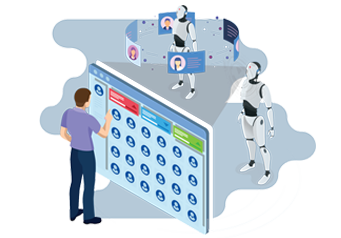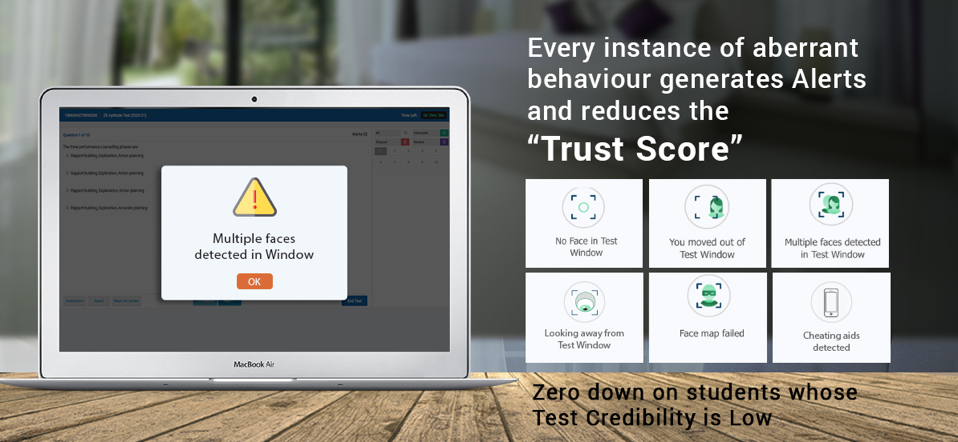
Live (Human) Proctoring augmented by AI intelligence
Instruction has moved to Virtual Classrooms, so have Examinations!
As the semester comes to an end, the COEs and Chief Examiners are gearing up for online examinations. Digital transformation of the education system – both public and private - is inevitable. Just like businesses have embraced WFH and wish to continue with it even after the tide subsides, academia is also embracing “Exams from Home” as the new normal.
Teachers no longer need to waste their valuable time in creating questions papers (repeatedly), marking the answer sheets (of objective questions), and doing on-site invigilation. Students appear for exams from the comfort of their homes – which has proved to be less stressful – under the watchful eye of AI, closely monitored by human proctors through virtual classrooms in real-time. Central Vigilance Console at the institution allows COE to control the conduct of the examination and ensure use of fair practices.
AI Augmented Live Proctoring

Live (human) proctoring is now being augmented from the intelligence gained by using advanced Machine and Deep Learning algorithms. DigiProctor Advanced enables institution to create ‘intelligent virtual classrooms’ where students appear for their examinations. Virtual classrooms are continuously monitored by human proctors and artificial intelligence (AI).
Institutions can allocate these classrooms to their students appearing for the exams and assign one or more human proctors. There can be multiple exams going on simultaneously in multiple virtual classrooms. Proctors can either monitor a single classroom or randomly enter different classrooms and take action against students demonstrating aberrant behaviour (which means students with low Trust Scores who have been alerted by AI for misconduct).
Trust Score and Test Credibility
Your student’s trust score is a reliable measure of the behaviour the student has displayed during the conduct of the exams – a low trust score indicates that student has impersonated, cheated, collaborated or used unfair means while taking the test. Intelligent algorithms generate ‘alerts’ (visible to students on their computer screens) to deter malpractices and each ‘alert’ generated by the algorithm reduces the student’s ‘Trust Score”. Human proctors have all this information on their dashboard (proctoring console) and can take necessary action as per test guidelines.

How AI helps the human proctors to tag students and/or terminate the test?
Your students take their “Exams from Home” and are proctored by artificial intelligence, which in turn gives insights to your human proctors to take action in real-time.
- AI is used for biometric authentication through facial analytics for student to enter the test
- Student’s registration photo is compared with his/her face and ID card to permit entry into test
- The test is taken on a test pad which locks up the test environment preventing candidate to navigate out, including locking keyboard and ports
- Throughout the duration of test the student is monitored for any non-compliance like moving out, talking, collaborating, or someone else taking test on test taker’s behalf
- Student’s screen is also continuously monitored to verify if he/she is moving out of test window to search for information using google etc.
- With each non-compliance the student’s Trust Score (which starts off at 100), is reduced by the seriousness of the non-compliance
- Human Proctor can easily determine the suspicious students by viewing their Trust Scores
- Humans Proctors are allotted students to monitor the test - they can chat with students and terminate or pause their test
- Logs of students behaviour are available to Proctors to take corrective action
Human Proctors can deter any aberrant behaviour of the student during the exam by using:
- Chat – students are issued warnings prior to any stringent action is taken
- Pause – student’s test is paused to warn them or do a test environment scan
- Terminate– student’s test is terminated by Chief Examiner or COE
In case of an exigency like power/Internet failure students can move the test to their mobile devices without any loss of data. System monitors for and automatically prevents any parallel sessions of the same test.
Chief Examiner can pay a visit to any Virtual Classrooms in real-time to ensure the use of fair practices during the conduct of the exam.
- All monitoring evidence is stored and available to Chief Examiner for review – which includes students’ recordings and recording of their screen activity during the test.
- Notification service - Candidates can be instantly messaged by COE on important issues during the test
- Evidentiary image of every non-compliant activity that led to drop in trust score is time-stamped, and can be instantly viewed anytime later
Remote online examination has ushered in high productivity in the critical examination process of institutions - exam planning cycles can be crunched, more frequent and ‘on-demand’ tests can be conducted, evaluations and result declarations can be much easier and quicker, question paper setting and answer paper evaluation done online can bring in huge productivity and time gains, the experience of students is much better, and cheating and impersonation during exams is significantly curbed.
At DigiProctor, we are continuously innovating our solution to meet every aspiration and ensure that Exams move online just as education has.








